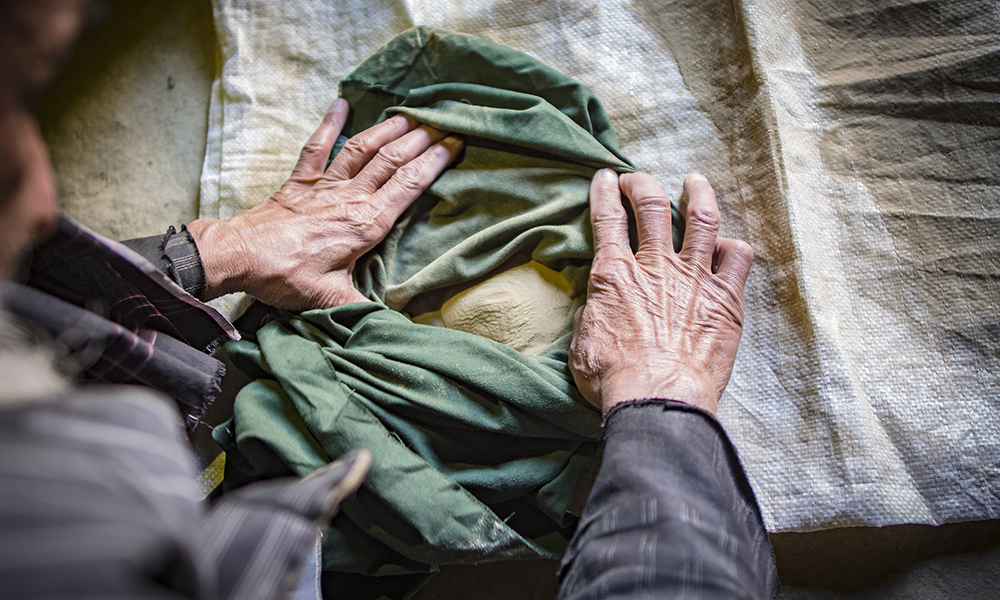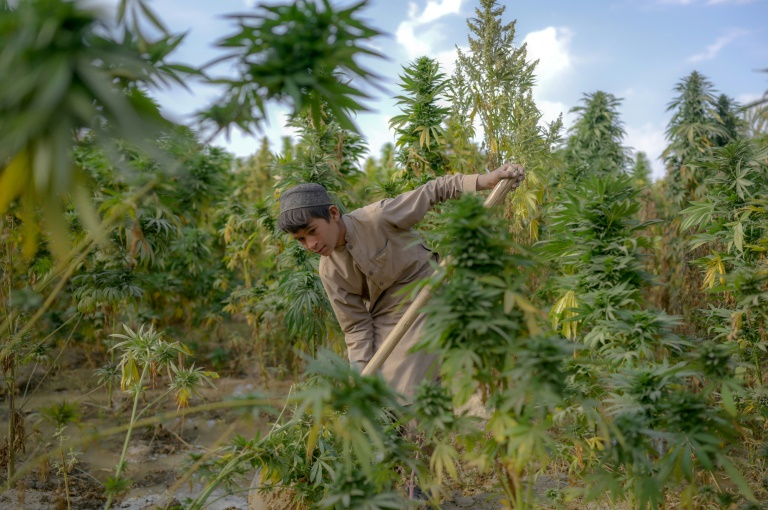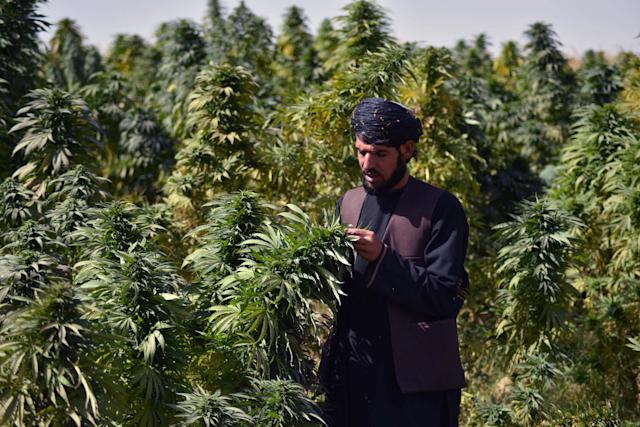





Cannabis in Afghanistan is illegal. It has been cultivated for centuries, and experienced relatively little interference until the 1970s, where after it became an issue both in international politics and in the finance of the series of wars which occurred in Afghanistan for forty years. In 2010, the United Nations reported that Afghanistan was the world's top cannabis producer.
Cannabis Indica is native to Afghanistan. With Cannabis Sativa also originating in Central Asia, it is likely that all existing cannabis strains originated from Afghanistan.
Whether Vavilov unintentionally fathered the name of what would almost half a century later become known as Afghan Black, the common contemporary name for the Afghan hashish is a subject of historical speculation. Nevertheless, Vavilov’s observations confirmed that farmers who cultivated hemp often collected seeds from wild hemp types to enrich their fields. It is quite possible that this Afghan-specific wild hemp type gradually became cultivated hemp and thus its main product – hashish or chars – became known as ‘Afghan Black’. According to Clarke (1998), this is exactly what happened. He found that the first report of hashish produced from Cannabis Indica, [forma] afghanica in northern Afghanistan dates from 1965; asserting an implicit explanation of how Vavilov’s ‘black hemp’ came to be known as ‘Afghan Black’.
Cannabis cultivation and hashish production in Afghanistan
Afghanistan has a tradition of chars (resin) manufacture using sieving techniques probably dating back to the nineteenth century . Cultivation of cannabis and trade in chars represented a major economic asset for some areas of Afghanistan (Balkh, Khyber and surrounding areas) at the end of the nineteenth and beginning of the twentieth centuries.
Garda chars. This inferior quality of chars is prepared by various artificial means from the hemp plant growing wild in mountainous regions… Cases of smuggling [it] into the North West Frontier Province and Baluchistan from Gardez in Afghanistan were quite common during the year.
As consumption in British India dwindled towards the late 1940s, so the story of Afghan chars production disappeared from historical records.
Conclusion
Although cannabis is an indigenous plant to Afghanistan and its region, it was not until the late nineteenth/early twentieth century that Afghanistan started producing chars for export mainly to markets in then-British India. Although consumption there dwindled in the late 1940s, the production and export of Afghan chars saw a ‘renaissance’ in the 1970s as its reach expanded beyond traditional markets to Europe. This expansion of the Afghan export market coincided with a general popularisation of hashish in modern culture and popular music, globally – with hippies as a hallmark of it. The hippies were also the bridge between relatively new western cultural narratives on hashish emanating from nineteenth and twentieth century poetry, literature and philosophy and the ancient ones of the east (detailed above).
The name ‘Afghan Black’ may have originated with Russian botanist Vavilov, who, in 1924 named Afghan cannabis the ‘black hemp’ because it grew ‘blackly’ among crops of maize and other cereals. Whether or not it did, it was the hippies who popularised the ‘brand’ of ‘Afghan Black’.
Among Afghans, the use of their own product has increased significantly during the last 40 years of conflict, as will be explored in the second dispatch in this series, which looks at the cultural history of consumption of ‘Afghan Black’ in Afghanistan. It is a rich, contradictory, sometimes poetic and sometimes bitter tale.
While traditional cultivation and largely local consumption of cannabis was common in Afghanistan, the development of the Hippie Trail in the 1970s brought an influx of young tourists with an appetite for cannabis to Afghanistan. Hashish had been made nominally illegal in 1957, allegedly mostly as a concession to US pressure, but persisted as a common drug in the country. However, increased production and sale to Western tourists raised the issue to the level of a social problem for the Afghan government. In 1972 Afghan authorities confiscated large amounts of refined heroin and hashish intended for export, revealing the increasingly international scope of drug production in the country. US pressure on Kabul hashish syndicates in 1971 further increased the tension around the issue.
During the 1970s, several Afghan citizens were also linked to The Brotherhood of Eternal Love commune in the United States. Kabul merchant Hyatullah Tohki transported hashish with his brother Amanullah, who worked at the American embassy in Kabul.
In 1973, King Zahir Shah outlawed opium poppy and cannabis production, this time followed by genuine commitment to eradication, backed by $47 million in funding from the United States government. That summer Afghan troops aggressively tackled production, destroying farms and arresting or killing cannabis farmers. Zahir Shah was deposed by his cousin Mohammed Daoud Khan that fall, who ended the monarchy and established himself as President, but the momentum of the hashish trade had been interrupted, and Western smugglers re-routed to Pakistani sources, so the 1973 harvest was minimal, as were harvests for several years following.
One consumption custom in Afghanistan is eating melon along with hashish, which is said to increase the high and decrease any negative side effects.
AFGHANI: OFTEN CALLED 'AFGHANI 1' OR SIMPLY 'AFGHAN'.
Afghani is more than just old school, it is prehistoric weed in a positive sense and perhaps as ancient as the Hindu Kush mountains themselves that straddle the border between Afghanistan and Pakistan and from which this strain originates.
Stoner lore has it that the prized Afghani landrace cannabis genetics were smuggled out of the region in the 1970s before the Soviet invasion.
Once in the hands of European and American breeders, the strain was refined and soon became the world's first true global cannabis strain, and a legend to boot.
For decades, ganja farmers in the Middle East and the Indian subcontinent have produced the finest hashish from Kush plants. Modern stabilized Afghani is not just a "hash plant", it is indica weed for connoisseurs.
Classic cannabis indicas like Afghani are gaining popularity again because it is a highly potent sinsemilla and, of course, because its sticky resin layer makes it exceptionally well suited for making extracts.
SMELL, TASTE AND EFFECT OF AFGHANI
The pungent aroma of Afghani contrasts sharply with the sweet, floral, and fruity smells of modern cannabis strains. Afghani smells lush, earthy and very much like hash. The resin with orange hairs is dense and and incredibly resinous. After a reasonable amount of curing time, notes of pine and citrus can burst forth.
If you pull on an Afghani you will definitely recognize it, newbies will almost certainly cough until they get a taste for vintage cannabis like this. Both the taste and the effect are far from subtle. The flavor of Afghani is full-bodied, woody, and reminiscent of black hash that is often extracted from the flowers. Some may consider Afghani too harsh, but if you give it a chance, much like coffee, you will learn to love it.
Afghani is a massive indica heirloom strain with no sativa ancestry, so she's definitely more suited for smoking at night than for an invigorating uplifting effect during the day. Couch-bound reluctance to move should be considered a given when smoking this weed. The deep physical broadside and long-lasting high of Afghani should not be underestimated. This old-timer still has the ability to land a knockout. The THC content of the best specimens can reach 20% or more.
Consumers of cannabis as medicine have long been fans of the strain, as an afghani provides the most effective relief from pain and helps treat a variety of conditions, from sleep disorders to chronic pain. In addition, consumers of afghani, either medicinally or recreationally, report significant subsequent stimulation of appetite, or enormous cravings, respectively.
HOW TO GROW AFGHANI
Afgani is a fantastic strain for novice growers, grandmasters and everyone in between. Even when grown from seed, the plants will be incredibly uniform, as if the plants were created from offshoots. Indoors, Afghani is the perfect SOG variety.
Small, lots of branches, and low maintenance: with genetics like these, you can't go far wrong when growing it. It requires minimal fertilizer and most growers consider Afghani a real addition to the grow tent.
Fast flowering and an excellent flower to leaf ratio allow for generous yields in just 7-8 weeks of flowering. Regardless of what your preferred indoor growing method is, from purist organic approaches, to hydroponics, to advanced aeroponics setups, Afghani never fails to reward the grower.
Outdoors, the variety can be grown well in southern Europe and is particularly suited to the Mediterranean climate of southern Spain and Italy. In addition, this variety is extremely hardy and resistant to mildew, so it can be grown successfully further north in a good summer.
Indoors, Afghani is usually no taller than 1m at harvest and, grown with SOG methods, can reach yields of up to 500g/m², while outdoors, 2 to 3 well-treated thick bushes can grow up to 2m tall and yield accordingly.